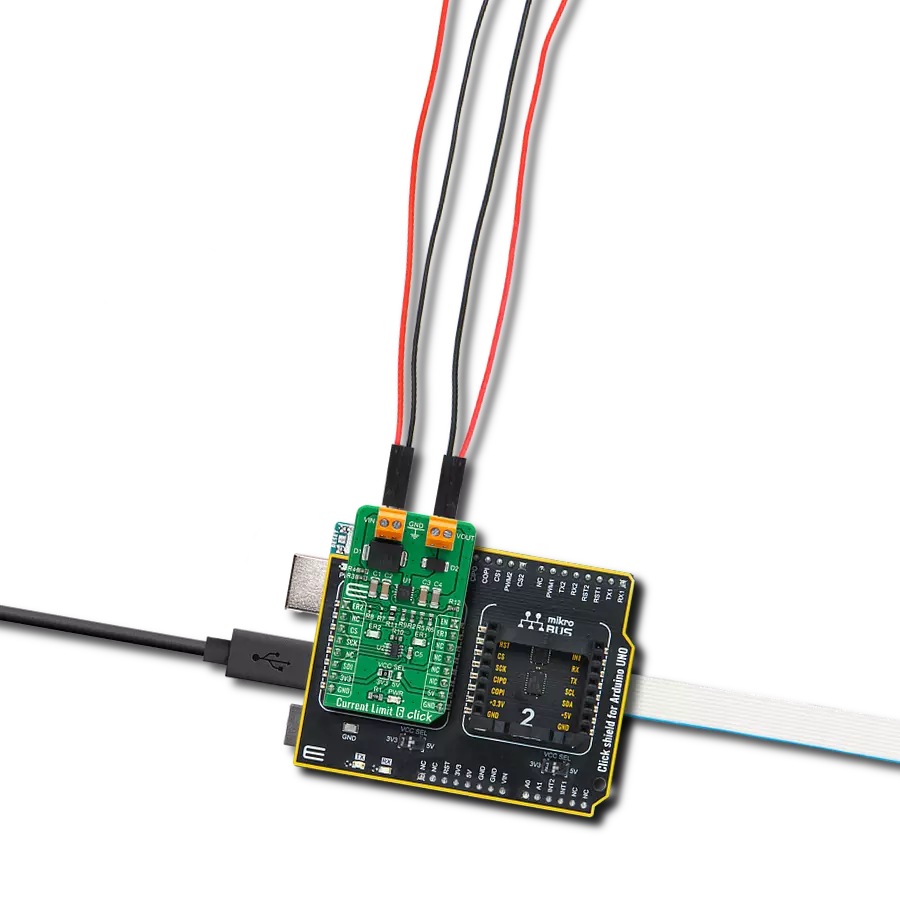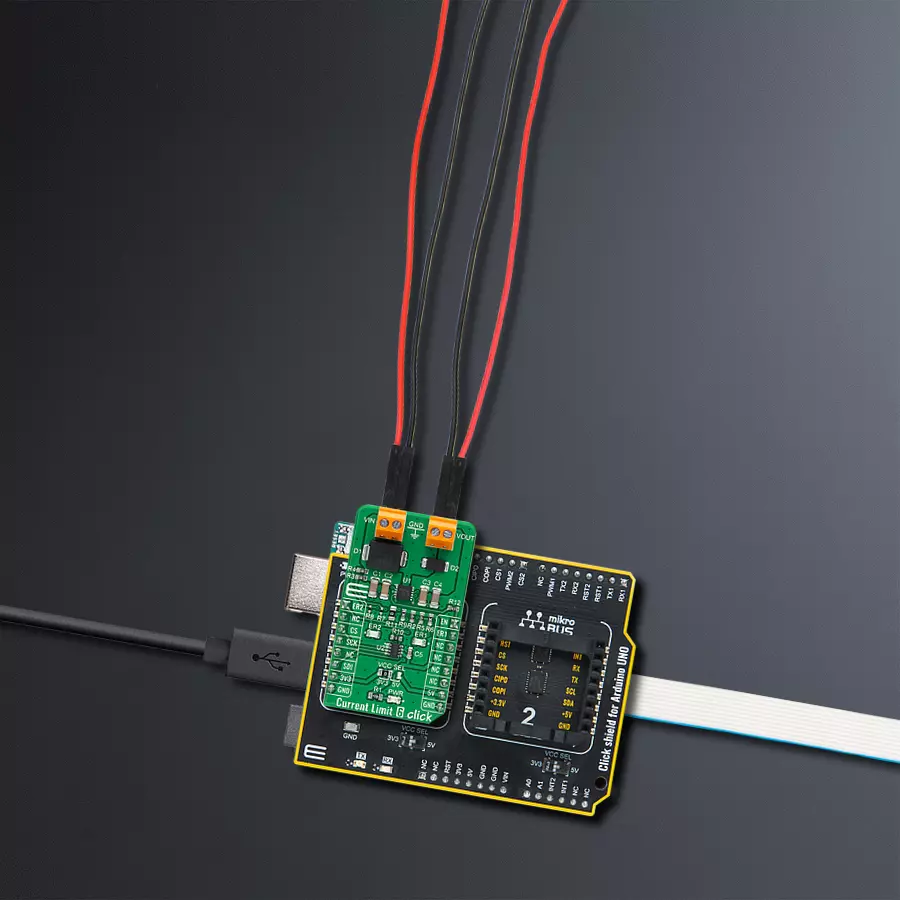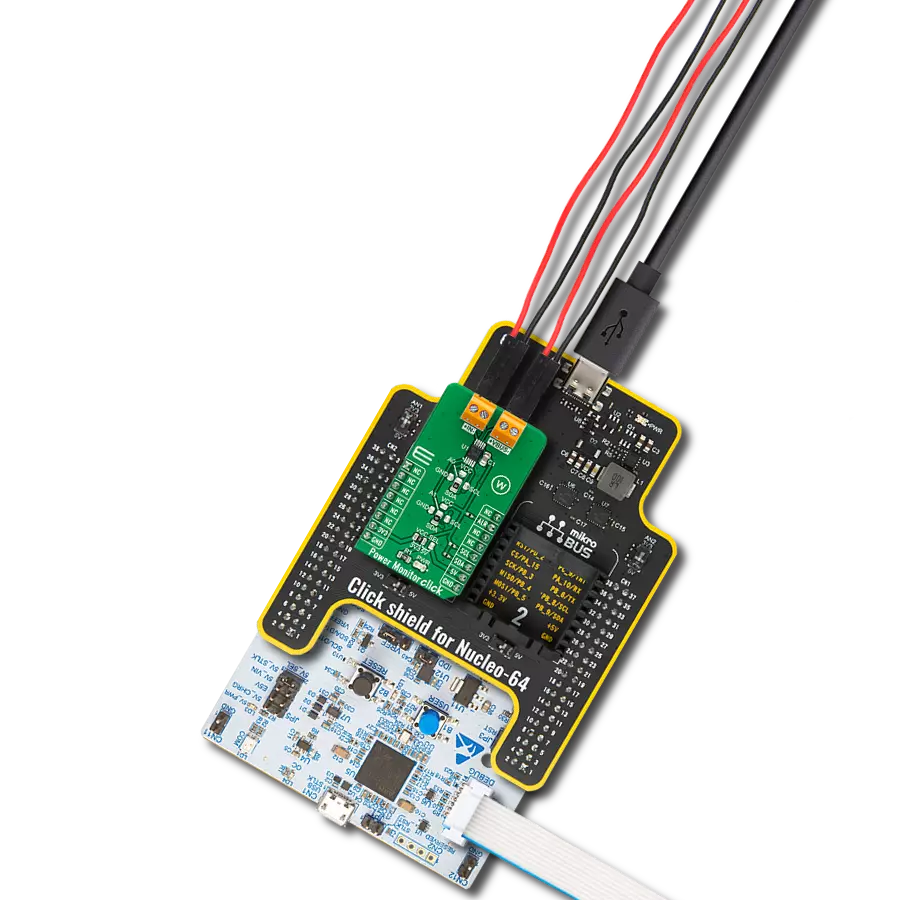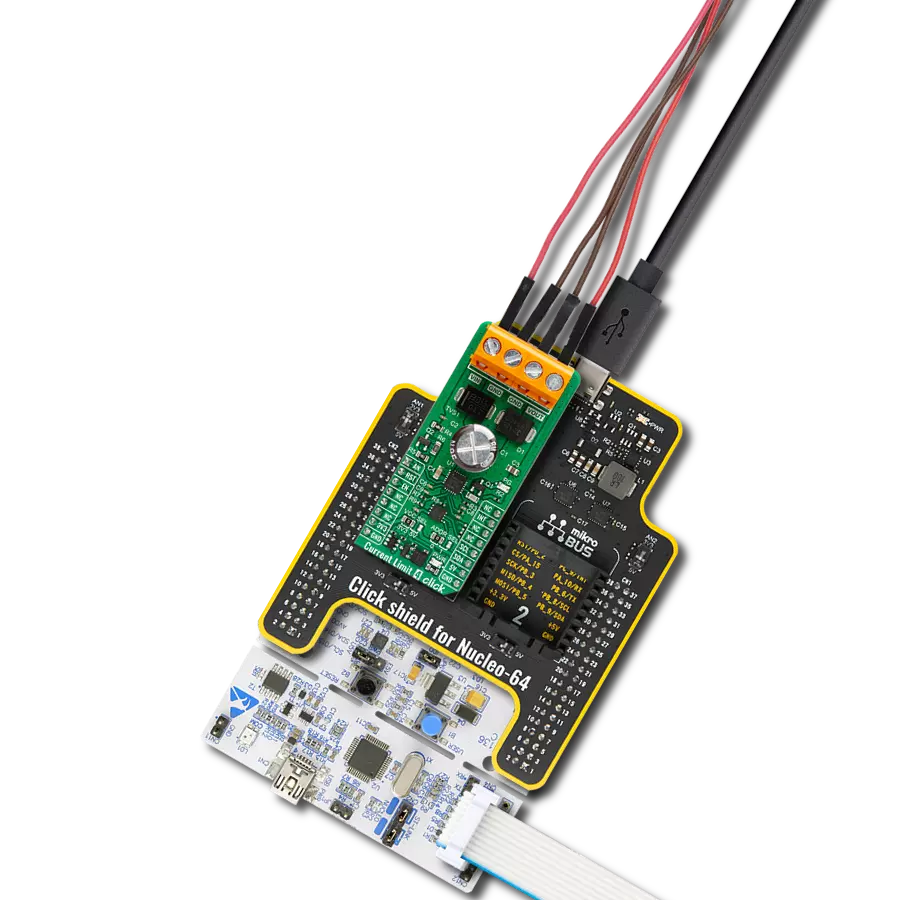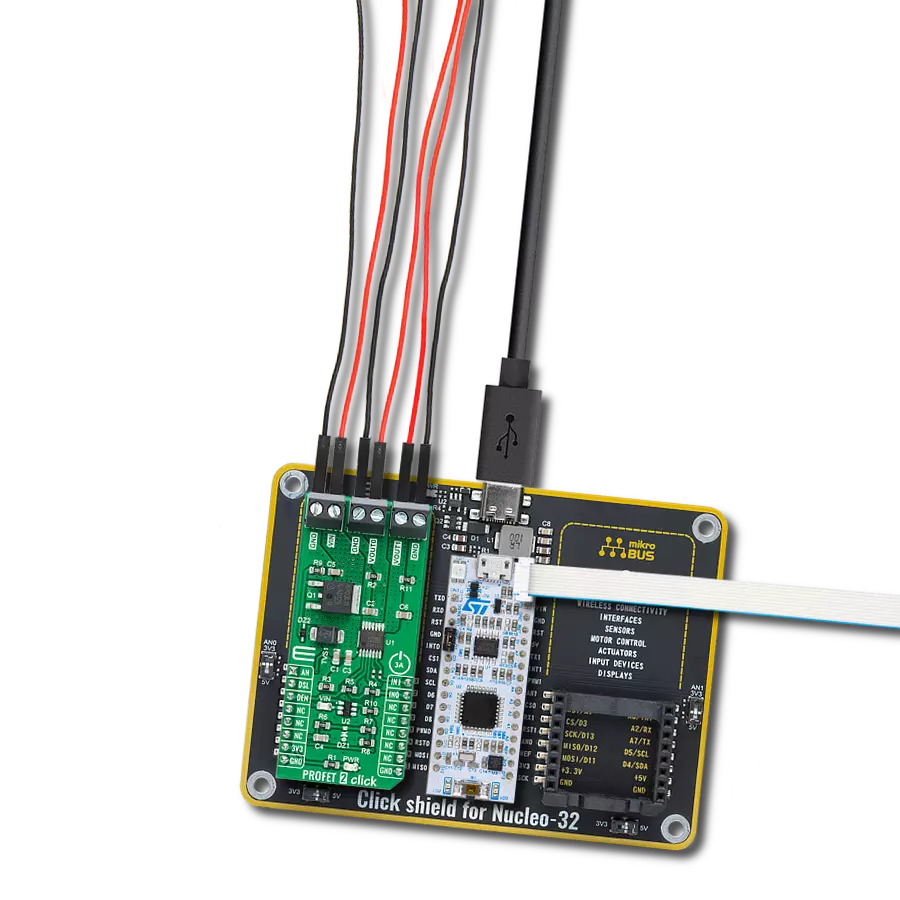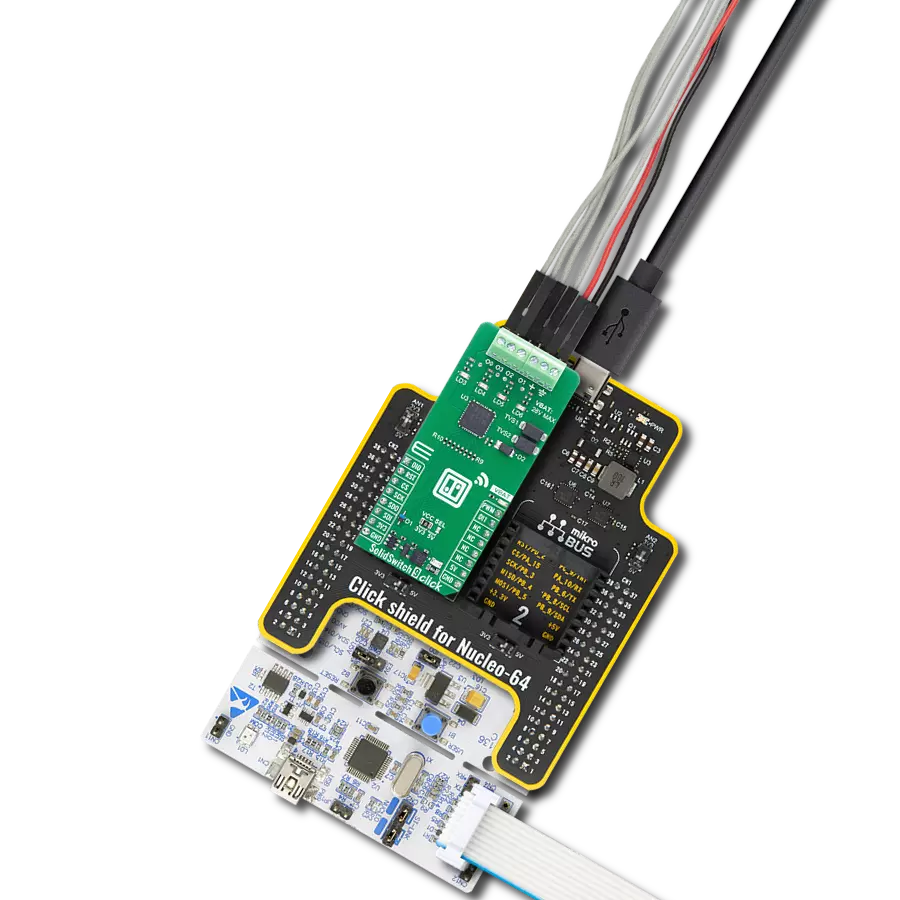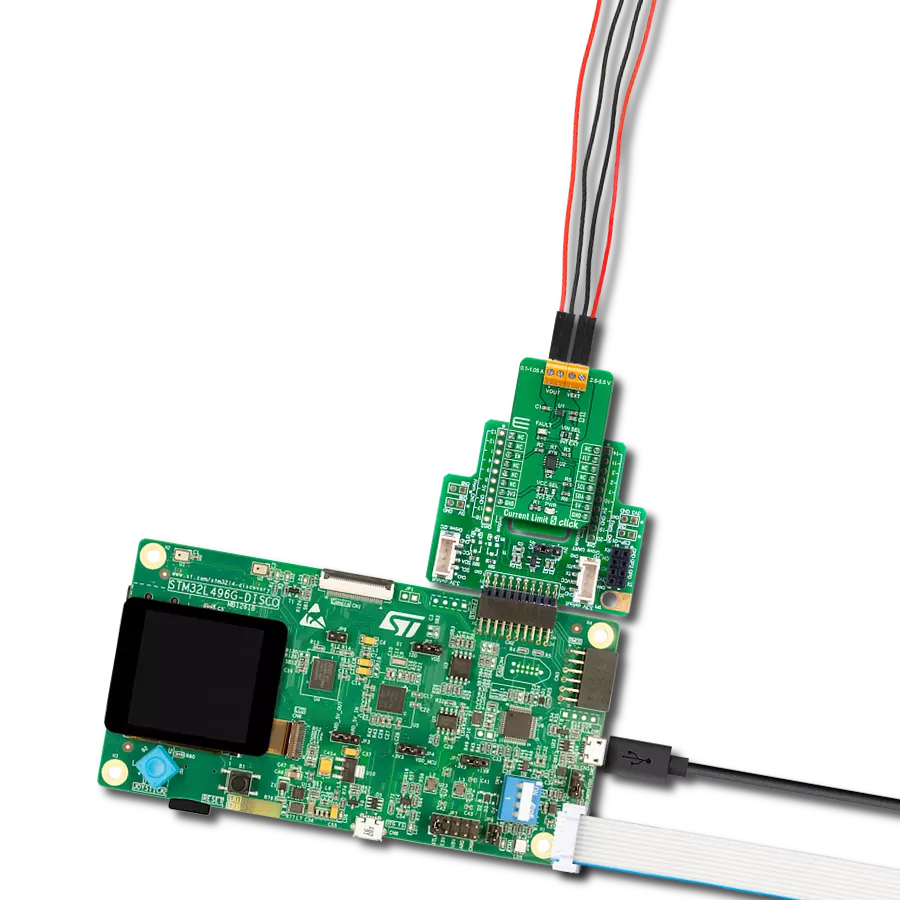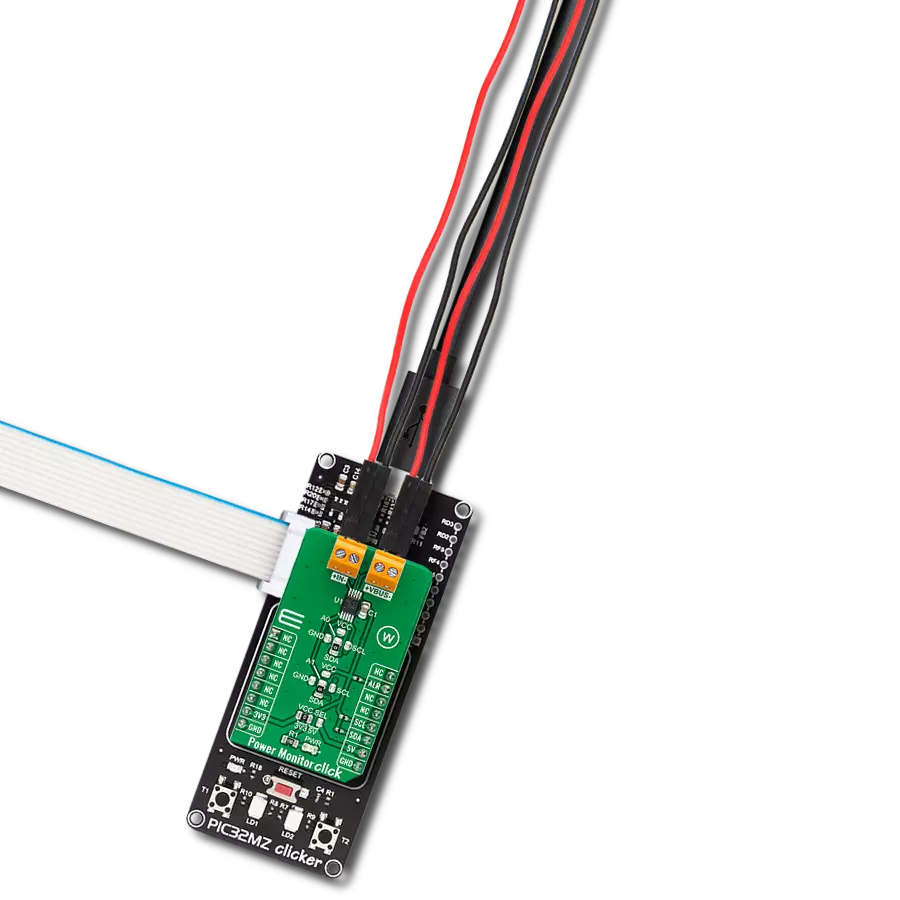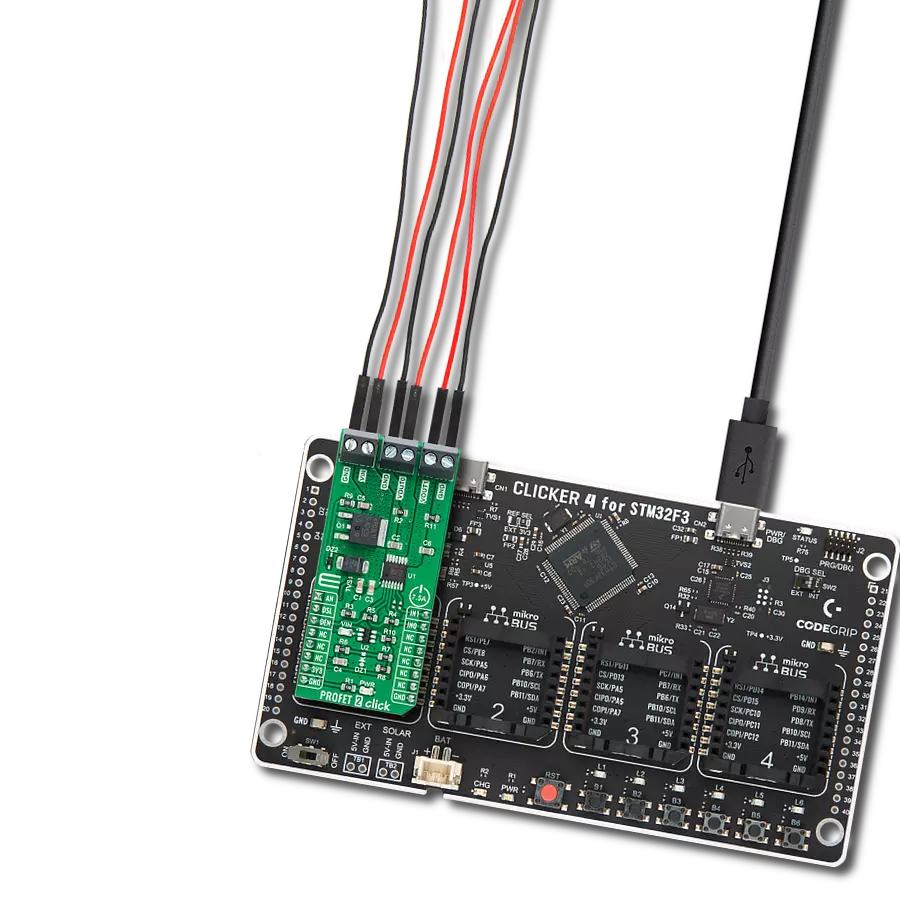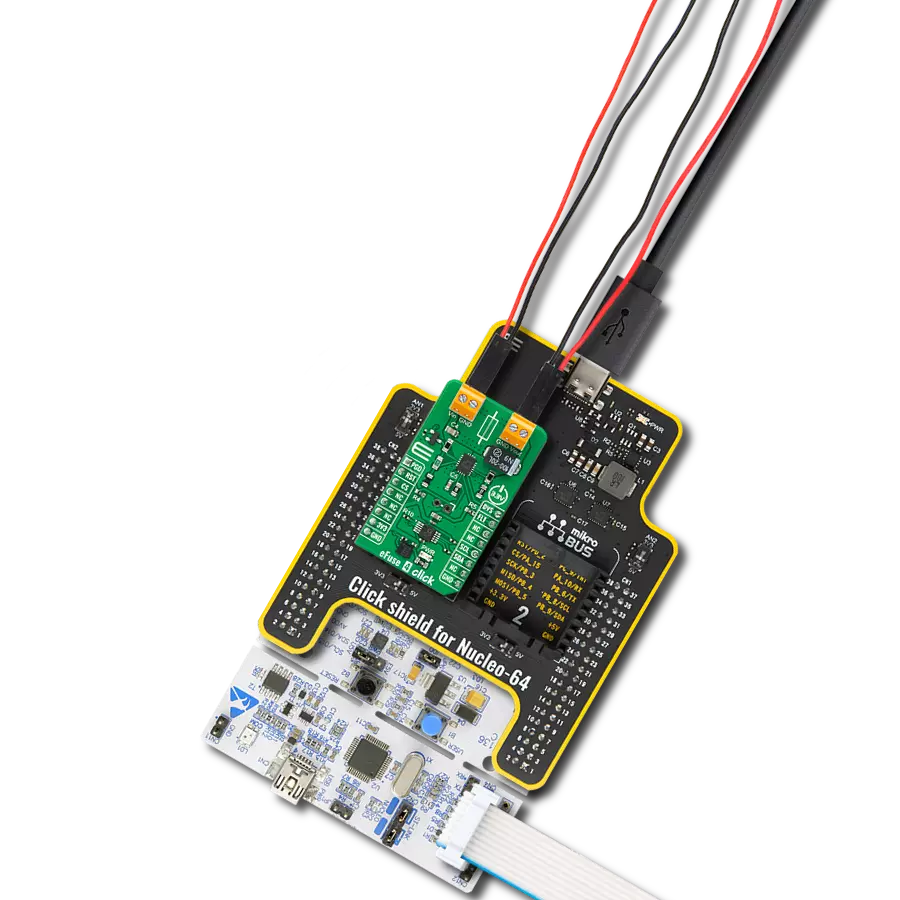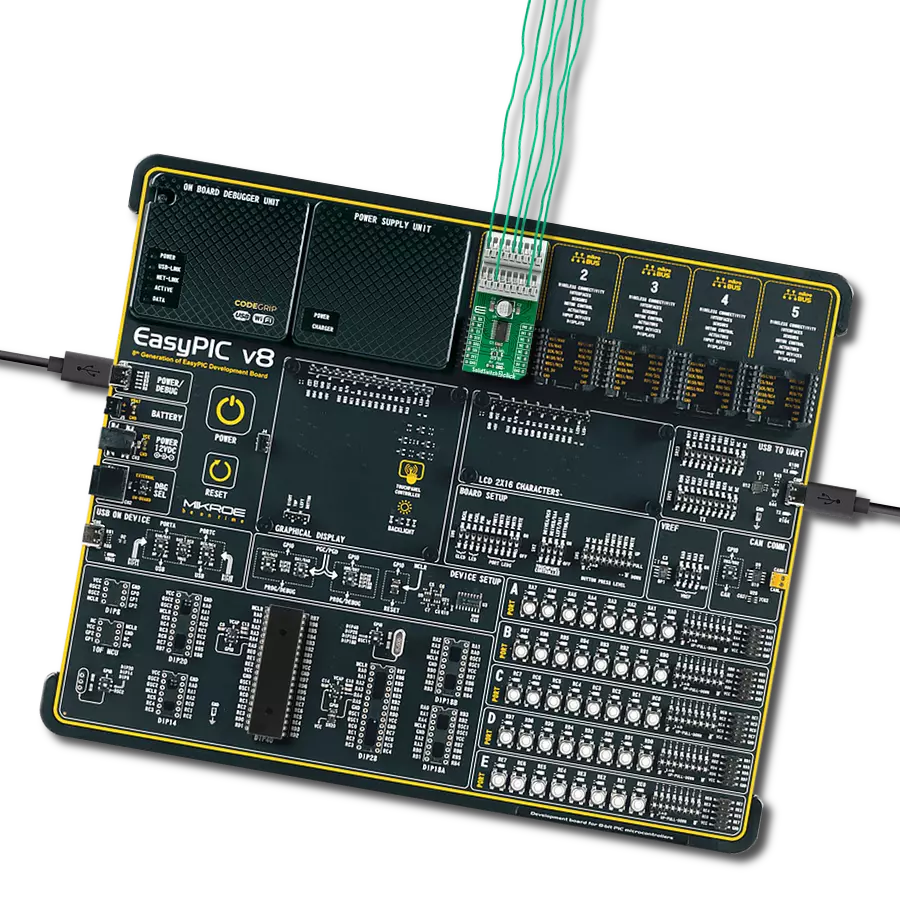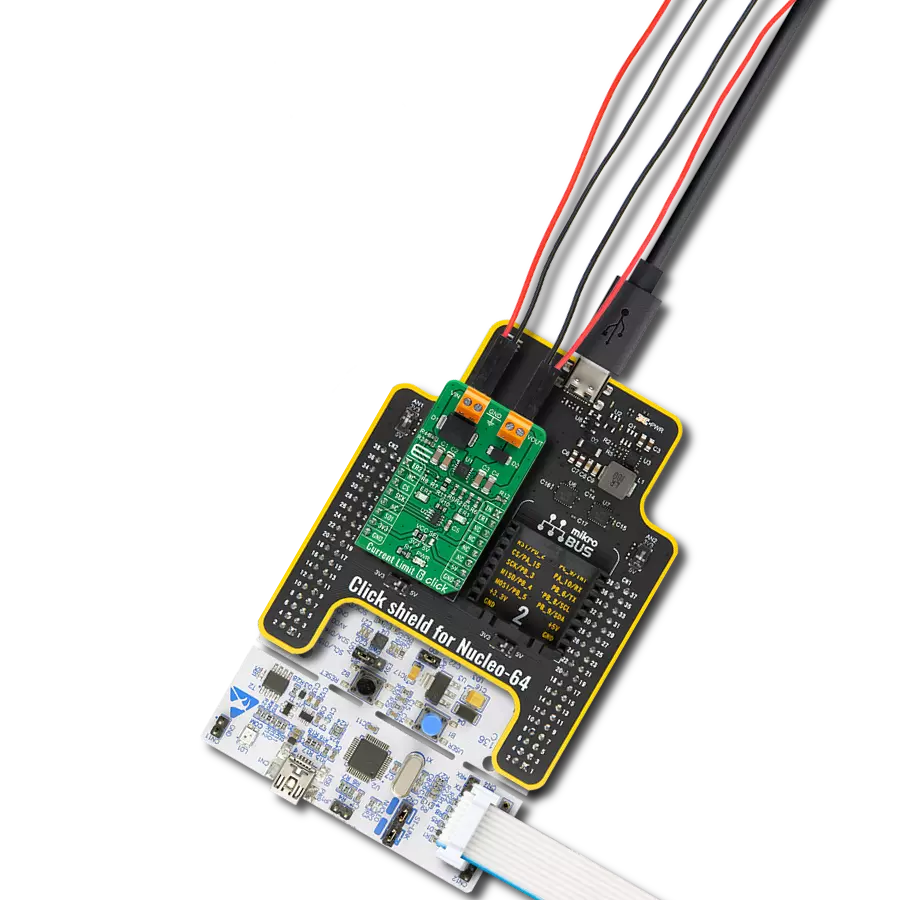我们的限流解决方案旨在革新安全性和效率,提供精确的电流控制,以确保最佳性能,同时保护您的系统免受过载影响。
A
A
硬件概览
它是如何工作的?
Current Limit 6 Click基于MAX17608,是来自Analog Devices的一款具有可调过电压和过电流保护功能的限流器件。MAX17608为系统提供灵活的保护边界,适用于输入电压范围为4.5V至60V,并将输出负载电流限制在预设水平(最高1A)。该器件还具有两个内部MOSFET串联连接,典型总RDS(on)为260mΩ。输入欠压保护可在4.5V至59V之间编程,而过压保护则可独立编程在5.5V至60V之间(默认Click板™配置为4.5V的UVLO和14V的OVLO)。此外,MAX17608具有内部默认欠压锁定,典型值为4V。限流开关几乎在系统控制中无处不在,提供了一种安全的手段来调节传递给负载电路的电流。它将负载电流增加到预设限值
但不会更高。通常,电流限值是外部电阻上的电压的函数,该电压作为内部限流放大器的参考。用数字电位器替换电阻,可以像在此Click板™上那样编程电流限值。为此,使用Analog Devices的MAX5401数字电位器,通过3线SPI串行接口与MCU通信,用于在MAX17608的SETI引脚上设置电阻,调节开关的电流限值在0.1A至1A之间。该限流器提供多种工作模式,可通过与MAX17608的CLMD引脚相连的R11跳线选择。在默认配置中,该引脚接地,表示连续工作模式。当R11替换为150kΩ电阻时,该Click板™处于锁存模式,当用户将此引脚悬空时,则激活自动重试模式。有关操作模式的更多信息请参阅附加的数据手册。
Current Limit 6 Click可通过mikroBUS™插座的PWM引脚连接的EN引脚打开或关闭,从而提供开关操作以打开/关闭对连接负载的电力传递。它还提供连接到mikroBUS™插座的INT和AN引脚的通信信号,以及其LED指示灯ER1和ER2,以指示不同的操作和故障信号,如FLAG和UVOV信号。此外,MAX17608还提供内部热关断保护,以防止过度功率耗散。该Click板™可通过VCC SEL跳线选择使用3.3V或5V逻辑电压水平。这样,既3.3V又5V的MCU都可以正确使用通信线路。此外,该Click板™配备了包含易于使用的功能和示例代码的库,可用作进一步开发的参考。
功能概述
开发板
Arduino UNO 是围绕 ATmega328P 芯片构建的多功能微控制器板。它为各种项目提供了广泛的连接选项,具有 14 个数字输入/输出引脚,其中六个支持 PWM 输出,以及六个模拟输入。其核心组件包括一个 16MHz 的陶瓷谐振器、一个 USB 连接器、一个电
源插孔、一个 ICSP 头和一个复位按钮,提供了为板 子供电和编程所需的一切。UNO 可以通过 USB 连接到计算机,也可以通过 AC-to-DC 适配器或电池供电。作为第一个 USB Arduino 板,它成为 Arduino 平台的基准,"Uno" 符号化其作为系列首款产品的地
位。这个名称选择,意为意大利语中的 "一",是为了 纪念 Arduino Software(IDE)1.0 的推出。最初与 Arduino Software(IDE)版本1.0 同时推出,Uno 自此成为后续 Arduino 发布的基础模型,体现了该平台的演进。
微控制器概述
MCU卡片 / MCU
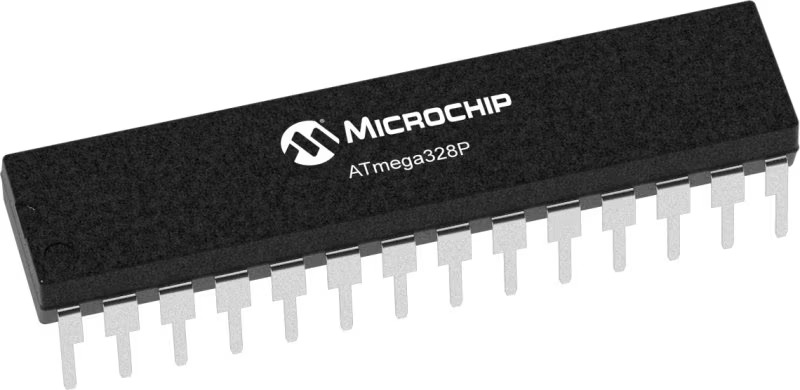
建筑
AVR
MCU 内存 (KB)
32
硅供应商
Microchip
引脚数
28
RAM (字节)
2048
你完善了我!
配件
Click Shield for Arduino UNO 具有两个专有的 mikroBUS™ 插座,使所有 Click board™ 设备能够轻松与 Arduino UNO 板进行接口连接。Arduino UNO 是一款基于 ATmega328P 的微控制器开发板,为用户提供了一种经济实惠且灵活的方式来测试新概念并构建基于 ATmega328P 微控制器的原型系统,结合了性能、功耗和功能的多种配置选择。Arduino UNO 具有 14 个数字输入/输出引脚(其中 6 个可用作 PWM 输出)、6 个模拟输入、16 MHz 陶瓷谐振器(CSTCE16M0V53-R0)、USB 接口、电源插座、ICSP 头和复位按钮。大多数 ATmega328P 微控制器的引脚都连接到开发板左右两侧的 IO 引脚,然后再连接到两个 mikroBUS™ 插座。这款 Click Shield 还配备了多个开关,可执行各种功能,例如选择 mikroBUS™ 插座上模拟信号的逻辑电平,以及选择 mikroBUS™ 插座本身的逻辑电压电平。此外,用户还可以通过现有的双向电平转换电压转换器使用任何 Click board™,无论 Click board™ 运行在 3.3V 还是 5V 逻辑电压电平。一旦将 Arduino UNO 板与 Click Shield for Arduino UNO 连接,用户即可访问数百种 Click board™,并兼容 3.3V 或 5V 逻辑电压电平的设备。
使用的MCU引脚
mikroBUS™映射器
“仔细看看!”
Click board™ 原理图

一步一步来
项目组装
软件支持
库描述
该库包含 Current Limit 6 Click 驱动程序的 API。
关键功能:
currentlimit6_set_current_limit- Current Limit 6 设置电流限制功能currentlimit6_power_mode- Current Limit 6 电源模式功能currentlimit6_check_limit_exceeded- Current Limit 6 检查是否超出限制功能
开源
代码示例
完整的应用程序代码和一个现成的项目可以通过NECTO Studio包管理器直接安装到NECTO Studio。 应用程序代码也可以在MIKROE的GitHub账户中找到。
/*!
* @file main.c
* @brief CurrentLimit6 Click example
*
* # Description
* This library contains API for the Current Limit 6 Click driver.
* This driver provides the functions to set the current limiting conditions
* in order to provide the threshold of the fault conditions.
*
* The demo application is composed of two sections :
*
* ## Application Init
* Initialization of SPI module and log UART.
* After driver initialization, default settings turn on the device.
*
* ## Application Task
* This example demonstrates the use of the Current Limit 6 Click board™.
* Reading user's input from Usart Terminal and using it as an index
* for an array of pre-calculated values that define the current limit level.
* Results are being sent to the Usart Terminal, where you can track their changes.
*
* ## Additional Function
* - static void display_selection ( void )
*
* @author Nenad Filipovic
*
*/
#include "board.h"
#include "log.h"
#include "currentlimit6.h"
static currentlimit6_t currentlimit6;
static log_t logger;
const float limit_value[ 9 ] = { 0.100, 0.200, 0.300, 0.400, 0.500, 0.600, 0.700, 0.800, 0.999 };
static void display_selection ( void )
{
log_printf( &logger, " To select current limit \r\n" );
log_printf( &logger, " Send one of the numbers: \r\n" );
log_printf( &logger, "- - - - - - - - - - - - - \r\n" );
log_printf( &logger, " '1' - Limited to 100 mA \r\n" );
log_printf( &logger, " '2' - Limited to 200 mA \r\n" );
log_printf( &logger, " '3' - Limited to 300 mA \r\n" );
log_printf( &logger, " '4' - Limited to 400 mA \r\n" );
log_printf( &logger, " '5' - Limited to 500 mA \r\n" );
log_printf( &logger, " '6' - Limited to 600 mA \r\n" );
log_printf( &logger, " '7' - Limited to 700 mA \r\n" );
log_printf( &logger, " '8' - Limited to 800 mA \r\n" );
log_printf( &logger, " '9' - Limited to 999 mA \r\n" );
log_printf( &logger, "--------------------------\r\n" );
}
void application_init ( void )
{
log_cfg_t log_cfg; /**< Logger config object. */
currentlimit6_cfg_t currentlimit6_cfg; /**< Click config object. */
/**
* Logger initialization.
* Default baud rate: 115200
* Default log level: LOG_LEVEL_DEBUG
* @note If USB_UART_RX and USB_UART_TX
* are defined as HAL_PIN_NC, you will
* need to define them manually for log to work.
* See @b LOG_MAP_USB_UART macro definition for detailed explanation.
*/
LOG_MAP_USB_UART( log_cfg );
log_init( &logger, &log_cfg );
log_info( &logger, " Application Init " );
// Click initialization.
currentlimit6_cfg_setup( ¤tlimit6_cfg );
CURRENTLIMIT6_MAP_MIKROBUS( currentlimit6_cfg, MIKROBUS_1 );
if ( SPI_MASTER_ERROR == currentlimit6_init( ¤tlimit6, ¤tlimit6_cfg ) )
{
log_error( &logger, " Communication init." );
for ( ; ; );
}
if ( CURRENTLIMIT6_ERROR == currentlimit6_default_cfg ( ¤tlimit6 ) )
{
log_error( &logger, " Default configuration." );
for ( ; ; );
}
log_info( &logger, " Application Task " );
log_printf( &logger, "-------------------------\r\n" );
log_printf( &logger, " Current Limit 6 Click \r\n" );
log_printf( &logger, "-------------------------\r\n" );
log_printf( &logger, "- - - - - - - - - - - - -\r\n" );
Delay_ms ( 100 );
display_selection( );
Delay_ms ( 100 );
}
void application_task ( void )
{
static char index;
if ( log_read( &logger, &index, 1 ) != CURRENTLIMIT6_ERROR )
{
if ( ( index >= '1' ) && ( index <= '9' ) )
{
currentlimit6_set_current_limit ( ¤tlimit6, limit_value[ index - 49 ] );
log_printf( &logger, " >>> Selected mode %d \r\n", index - 48 );
log_printf( &logger, "- - - - - - - - - - - - -\r\n" );
log_printf( &logger, " Current limit is %.3f A \r\n", limit_value[ index - 49 ] );
log_printf( &logger, "--------------------------\r\n" );
Delay_ms ( 100 );
}
else
{
log_printf( &logger, " Data not in range! \r\n" );
log_printf( &logger, "--------------------------\r\n" );
display_selection( );
Delay_ms ( 100 );
}
}
}
int main ( void )
{
/* Do not remove this line or clock might not be set correctly. */
#ifdef PREINIT_SUPPORTED
preinit();
#endif
application_init( );
for ( ; ; )
{
application_task( );
}
return 0;
}
// ------------------------------------------------------------------------ END
额外支持
资源
类别:电源开关
